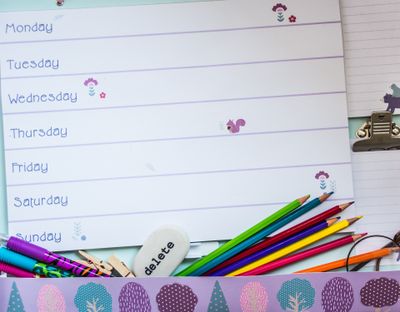Water Cooler: Getting organized for the new school year

Life is about to get a lot busier with the new school year just around the corner. Staying organized from the get-go will make for an easier transition out of summer break mode and will set your young learner up for success throughout the year. Here are some tips to help you and your child stay organized from the very start.
Make a place for everything. It’s easy to forget to bring things to school if belongings and homework are scattered throughout the house. Designate a basket, cubby, shelf, etc. for the school items only. This can be a place to keep backpacks, projects, homework, and anything that needs to go with your child to school the next day.
Color code subjects. A backpack full of books, syllabi, folders, notebooks and forms can be overwhelming, especially for young learners. Keep it simple by assigning a color to each class or subject. Buy notebooks, folders or binders and other supplies in the assigned colors for each subject. This will help your child stay organized at a glance. The less effort it takes to stay organized, the better.
Use a planner or calendar. Work with your child to develop the habit of writing important deadlines, test days, activities, etc. into a calendar. It can be digital or hard copy. A planner that provides a weekly log as well as a month at a glance is great for being able to record detailed daily information as well as quick entries for test dates later in the semester or quarter. This helps you and your child be mentally prepared for upcoming tasks and can help prevent last-minute cramming or preparation.
Create a study space. Having a physical space dedicated to working is beneficial for kids and adults alike. It can be a helpful cue for your brain that it is time to focus on a specific task. A study space is a great area to keep past assignments, reference books and supplies. Keeping a space dedicated to school work also makes it easier to ensure there is always a clean space to work in, avoiding the extra step of needing to clear an area before beginning homework.
Break big tasks into small steps. Starting a huge project or a pile of homework can be daunting. Help your child face their school work by breaking it down into the simplest of steps, beginning with gathering the necessary supplies for the project. Then work together to decide on the first steps to completing the assignment. For example, the first steps to writing an essay can be creating a flowchart or brainstorming map to bounce around various ideas. The next step could be to decide on a topic or thesis. Follow that with creating an outline. Create a checklist for each step so your child feels accomplished as the work toward completing the assignment.
Designate a letter tray to school-related paperwork. The beginning of the school year often means a lot of forms. Designating a letter tray or mail spot for school forms provides a place for your child to put forms immediately after they receive them to help ensure they don’t get lost in the shuffle of other school papers.
Clean backpacks weekly. It’s easy for a backpack to become a catch all of forgotten, crumbled homework, debris, returned assignments and the like. Picking a day for a weekly backpack cleaning keeps the backpack from accumulating clutter and helps prevent important papers from getting lost. File old notes and graded assignments in a filing system at home so they don’t have to be lugged around every day at school.